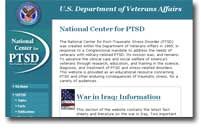 We've already looked at the VA's official definition of post-traumatic stress disorder; now we'll expand on that by taking a look at the VA's National Center for PTSD definition. The more ways we look at PTSD, the better.
We've already looked at the VA's official definition of post-traumatic stress disorder; now we'll expand on that by taking a look at the VA's National Center for PTSD definition. The more ways we look at PTSD, the better.
Click on 'Article Link' below tags for more...
Much of the information at the National Center for PTSD website is in the public domain, giving everyone the right to share the information with others elsewhere. The following is from their What is Posttraumatic Stress Disorder? fact sheet:
Posttraumatic Stress Disorder, or PTSD, is a psychiatric disorder that can occur following the experience or witnessing of life-threatening events such as military combat, natural disasters, terrorist incidents, serious accidents, or violent personal assaults like rape. Most survivors of trauma return to normal given a little time. However, some people will have stress reactions that do not go away on their own, or may even get worse over time. These individuals may develope PTSD. People who suffer from PTSD often relive the experience through nightmares and flashbacks, have difficulty sleeping, and feel detached or estranged, and these symptoms can be severe enough and last long enough to significantly impair the person's daily life.
PTSD is marked by clear biological changes as well as psychological symptoms. PTSD is complicated by the fact that it frequently occurs in conjunction with related disorders such as depression, substance abuse, problems of memory and cognition, and other problems of physical and mental health. The disorder is also associated with impairment of the person's ability to function in social or family life, including occupational instability, marital problems and divorces, family discord, and difficulties in parenting.

Understanding PTSD
PTSD is not a new disorder. There are written accounts of similar symptoms that go back to ancient times, and there is clear documentation in the historical medical literature starting with the Civil War, when a PTSD-like disorder was known as "Da Costa's Syndrome." There are particularly good descriptions of posttraumatic stress symptoms in the medical literature on combat veterans of World War II and on Holocaust survivors.
Careful research and documentation of PTSD began in earnest after the Vietnam War. The National Vietnam Veterans Readjustment Study estimated in 1988 that the prevalence of PTSD in that group was 15.2% at that time and that 30% had experienced the disorder at some point since returning from Vietnam.
PTSD has subsequently been observed in all veteran populations that have been studied, including World War II, Korean conflict, and Persian Gulf populations, and in United Nations peacekeeping forces deployed to other war zones around the world. There are remarkably similar findings of PTSD in military veterans in other countries. For example, Australian Vietnam veterans experience many of the same symptoms that American Vietnam veterans experience.
PTSD is not only a problem for veterans, however. Although there are unique cultural- and gender-based aspects of the disorder, it occurs in men and women, adults and children, Western and non-Western cultural groups, and all socioeconomic strata. A national study of American civilians conducted in 1995 estimated that the lifetime prevalence of PTSD was 5% in men and 10% in women. A revision of this study done in 2005, reports that PTSD occurs in about 8% of all Americans.

How does PTSD develop?
Most people who are exposed to a traumatic, stressful event experience some of the symptoms of PTSD in the days and weeks following exposure. Available data suggest that about 8% of men and 20% of women go on to develop PTSD, and roughly 30% of these individuals develop a chronic form that persists throughout their lifetimes.
The course of chronic PTSD usually involves periods of symptom increase followed by remission or decrease, although some individuals may experience symptoms that are unremitting and severe. Some older veterans, who report a lifetime of only mild symptoms, experience significant increases in symptoms following retirement, severe medical illness in themselves or their spouses, or reminders of their military service (such as reunions or media broadcasts of the anniversaries of war events).
How is PTSD assessed?
In recent years, a great deal of research has been aimed at developing and testing reliable assessment tools. It is generally thought that the best way to diagnose PTSD-or any psychiatric disorder, for that matter-is to combine findings from structured interviews and questionnaires with physiological assessments. A multi-method approach especially helps address concerns that some patients might be either denying or exaggerating their symptoms.

How common is PTSD?
An estimated 7.8 percent of Americans will experience PTSD at some point in their lives, with women (10.4%) twice as likely as men (5%) to develop PTSD. About 3.6 percent of U.S. adults aged 18 to 54 (5.2 million people) have PTSD during the course of a given year. This represents a small portion of those who have experienced at least one traumatic event; 60.7% of men and 51.2% of women reported at least one traumatic event. The traumatic events most often associated with PTSD for men are rape, combat exposure, childhood neglect, and childhood physical abuse. The most traumatic events for women are rape, sexual molestation, physical attack, being threatened with a weapon, and childhood physical abuse.
About 30 percent of the men and women who have spent time in war zones experience PTSD. An additional 20 to 25 percent have had partial PTSD at some point in their lives. More than half of all male Vietnam veterans and almost half of all female Vietnam veterans have experienced "clinically serious stress reaction symptoms." PTSD has also been detected among veterans of the Gulf War, with some estimates running as high as 8 percent.

Who is most likely to develop PTSD?
- Those who experience greater stressor magnitude and intensity, unpredictability, uncontrollability, sexual (as opposed to nonsexual) victimization, real or perceived responsibility, and betrayal
- Those with prior vulnerability factors such as genetics, early age of onset and longer-lasting childhood trauma, lack of functional social support, and concurrent stressful life events
- Those who report greater perceived threat or danger, suffering, upset, terror, and horror or fear
- Those with a social environment that produces shame, guilt, stigmatization, or self-hatred

What are the consequences associated with PTSD?
PTSD is associated with a number of distinctive neurobiological and physiological changes. PTSD may be associated with stable neurobiological alterations in both the central and autonomic nervous systems, such as altered brainwave activity, decreased volume of the hippocampus, and abnormal activation of the amygdala. Both the hippocampus and the amygdala are involved in the processing and integration of memory. The amygdala has also been found to be involved in coordinating the body's fear response.
Psychophysiological alterations associated with PTSD include hyper-arousal of the sympathetic nervous system, increased sensitivity of the startle reflex, and sleep abnormalities.
People with PTSD tend to have abnormal levels of key hormones involved in the body's response to stress. Thyroid function also seems to be enhanced in people with PTSD. Some studies have shown that cortisol levels in those with PTSD are lower than normal and epinephrine and norepinephrine levels are higher than normal. People with PTSD also continue to produce higher than normal levels of natural opiates after the trauma has passed. An important finding is that the neurohormonal changes seen in PTSD are distinct from, and actually opposite to, those seen in major depression. The distinctive profile associated with PTSD is also seen in individuals who have both PTSD and depression.
PTSD is associated with the increased likelihood of co-occurring psychiatric disorders. In a large-scale study, 88 percent of men and 79 percent of women with PTSD met criteria for another psychiatric disorder. The co-occurring disorders most prevalent for men with PTSD were alcohol abuse or dependence (51.9 percent), major depressive episodes (47.9 percent), conduct disorders (43.3 percent), and drug abuse and dependence (34.5 percent). The disorders most frequently comorbid with PTSD among women were major depressive disorders (48.5 percent), simple phobias (29 percent), social phobias (28.4 percent), and alcohol abuse/dependence (27.9 percent).
PTSD also significantly impacts psychosocial functioning, independent of comorbid conditions. For instance, Vietnam veterans with PTSD were found to have profound and pervasive problems in their daily lives. These included problems in family and other interpersonal relationships, problems with employment, and involvement with the criminal justice system.
Headaches, gastrointestinal complaints, immune system problems, dizziness, chest pain, and discomfort in other parts of the body are common in people with PTSD. Often, medical doctors treat the symptoms without being aware that they stem from PTSD.

How is PTSD treated?
PTSD is treated by a variety of forms of psychotherapy (talk therapy) and drug therapy. There is no definitive treatment, but some treatments appear to be quite promising, especially cognitive-behavioral therapy, group therapy, and exposure therapy. Exposure therapy involves having the patient repeatedly relive the frightening experience under controlled conditions to help him or her work through the trauma. Studies have also shown that medications help ease associated symptoms of depression and anxiety and help with sleep. The most widely used drug treatments for PTSD are the selective serotonin reuptake inhibitors, such as Prozac and Zoloft. At present, cognitive-behavioral therapy appears to be somewhat more effective than drug therapy. However, it would be premature to conclude that drug therapy is less effective overall since drug trials for PTSD are at a very early stage. Drug therapy appears to be highly effective for some individuals and is helpful for many more. In addition, the recent findings on the biological changes associated with PTSD have spurred new research into drugs that target these biological changes, which may lead to much increased efficacy.

Related Fact Sheets
Epidemiology - Information about rates of PTSD in the United States among different populations
Help for veterans with PTSD - Answers to some questions about PTSD and service-connected disability that are frequently asked by veterans and their families
Risk factors - A fact sheet about the risk factors for adverse outcomes in natural and human-caused disasters
Treatment - Information on availble treatments for PTSD
Be sure to spend some time exploring the entire National Center for PTSD website; it will be time well spent.

Related Posts
 Recently, a sculptor pointed me in the direction of her series of figurative pieces created while she was in therapy for PTSD. At the Tri State Sculptors website, Kim Marchesseault (who blogs at Spackel) says of her work:
Recently, a sculptor pointed me in the direction of her series of figurative pieces created while she was in therapy for PTSD. At the Tri State Sculptors website, Kim Marchesseault (who blogs at Spackel) says of her work:




